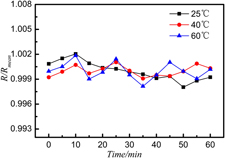Crossref Citations
This article has been cited by the following publications. This list is generated based on data provided by
Crossref.
Park, Jonghwa
Kim, Marie
Lee, Youngoh
Lee, Heon Sang
and
Ko, Hyunhyub
2015.
Fingertip skin–inspired microstructured ferroelectric skins discriminate static/dynamic pressure and temperature stimuli.
Science Advances,
Vol. 1,
Issue. 9,
Qiu, Shihua
Huang, Ying
He, Xiaoyue
Sun, Zhiguang
Liu, Ping
and
Liu, Caixia
2015.
A dual-mode proximity sensor with integrated capacitive and temperature sensing units.
Measurement Science and Technology,
Vol. 26,
Issue. 10,
p.
105101.
Liu, Ping
Huang, Ying
Liu, Caixia
Wang, Yue
Guo, Xiaohui
Zhang, Yugang
and
Ge, Yunjian
2015.
Enhanced electrical conductivity and mechanical stability of flexible pressure-sensitive GNPs/CB/SR composites: Synergistic effects of GNPs and CB.
Journal of Materials Research,
Vol. 30,
Issue. 22,
p.
3394.
Blasdel, Nathaniel J.
and
Monty, Chelsea N.
2015.
Wearable Electronics Sensors.
Vol. 15,
Issue. ,
p.
193.
Huang, Ying
Wang, Weihua
Sun, Zhiguang
Wang, Yue
Liu, Ping
and
Liu, Caixia
2015.
A multilayered flexible piezoresistive sensor for wide-ranged pressure measurement based on CNTs/CB/SR composite.
Journal of Materials Research,
Vol. 30,
Issue. 12,
p.
1869.
Huang, Ying
Fang, Ding
Wu, Can
Wang, Weihua
Guo, Xiaohui
and
Liu, Ping
2016.
A flexible touch-pressure sensor array with wireless transmission system for robotic skin.
Review of Scientific Instruments,
Vol. 87,
Issue. 6,
Antonova, I. V.
Kotin, I. A.
Popov, V. I.
Vasileva, F. D.
Kapitonov, A. N.
and
Smagulova, S. A.
2016.
Graphene-oxide films printed on rigid and flexible substrates for a wide spectrum of applications.
Semiconductors,
Vol. 50,
Issue. 8,
p.
1065.
Lou, Cunguang
Li, Ruikai
Li, Zhaopeng
Liang, Tie
Wei, Zihui
Run, Mingtao
Yan, Xiaobing
and
Liu, Xiuling
2016.
Flexible Graphene Electrodes for Prolonged Dynamic ECG Monitoring.
Sensors,
Vol. 16,
Issue. 11,
p.
1833.
Banerjee, Indrani
Faris, Tsegie
Stoeva, Zlatka
Harris, Paul G
Chen, J
Sharma, Ashwani K
and
Ray, Asim K
2016.
Graphene films printable on flexible substrates for sensor applications.
2D Materials,
Vol. 4,
Issue. 1,
p.
015036.
Garoz-Ruiz, Jesus
Ibañez, David
Romero, Edna C.
Ruiz, Virginia
Heras, Aranzazu
and
Colina, Alvaro
2016.
Optically transparent electrodes for spectroelectrochemistry fabricated with graphene nanoplatelets and single-walled carbon nanotubes.
RSC Advances,
Vol. 6,
Issue. 37,
p.
31431.
Liparoti, Sara
Landi, Giovanni
Sorrentino, Andrea
Speranza, Vito
Cakmak, Mukerrrem
and
Neitzert, Heinz Christoph
2016.
Flexible Poly(Amide‐Imide)‐Carbon Black Based Microheater with High‐Temperature Capability and an Extremely Low Temperature Coefficient.
Advanced Electronic Materials,
Vol. 2,
Issue. 6,
Huang, Ying
Wang, Yue
Gao, Le
He, Xiaoyue
Liu, Ping
and
Liu, Caixia
2017.
Characterization of stretchable SWCNTs/Lycra fabric electrode with dyeing process.
Journal of Materials Science: Materials in Electronics,
Vol. 28,
Issue. 5,
p.
4279.
Huang, Ying
Cai, Xia
Kan, Wenqing
Qiu, Shihua
Guo, Xiaohui
Liu, Caixia
and
Liu, Ping
2017.
A flexible dual-mode proximity sensor based on cooperative sensing for robot skin applications.
Review of Scientific Instruments,
Vol. 88,
Issue. 8,
Antonova, Irina V.
2017.
2D printing technologies using graphene based materials.
Uspekhi Fizicheskih Nauk,
Vol. 187,
Issue. 2,
p.
220.
Cataldi, Pietro
Athanassiou, Athanassia
and
Bayer, Ilker S.
2018.
Graphene Nanoplatelets-Based Advanced Materials and Recent Progress in Sustainable Applications.
Applied Sciences,
Vol. 8,
Issue. 9,
p.
1438.
Kurian, Agee Susan
Mohan, Velram Balaji
and
Bhattacharyya, Debes
2018.
Embedded large strain sensors with graphene-carbon black-silicone rubber composites.
Sensors and Actuators A: Physical,
Vol. 282,
Issue. ,
p.
206.
Huang, Ying
Zeng, Xiao
Wang, Wendong
Guo, Xiaohui
Hao, Chao
Pan, Weidong
Liu, Ping
Liu, Caixia
Ma, Yuanming
Zhang, Yugang
and
Yang, Xiaoming
2018.
High-resolution flexible temperature sensor based graphite-filled polyethylene oxide and polyvinylidene fluoride composites for body temperature monitoring.
Sensors and Actuators A: Physical,
Vol. 278,
Issue. ,
p.
1.
Zhang, Jie
Tan, Wensheng
Tao, Yongxin
Deng, Linhong
Qin, Yong
and
Kong, Yong
2018.
A novel electrochemical chiral interface based on sandwich-structured molecularly imprinted SiO2/AuNPs/SiO2 for enantioselective recognition of cysteine isomers.
Electrochemistry Communications,
Vol. 86,
Issue. ,
p.
57.
Cao, Zherui
Yang, Yina
Zheng, Yinghui
Wu, Wei
Xu, Fangfang
Wang, Ranran
and
Sun, Jing
2019.
Highly flexible and sensitive temperature sensors based on Ti3C2Tx (MXene) for electronic skin.
Journal of Materials Chemistry A,
Vol. 7,
Issue. 44,
p.
25314.
Bang, Junsung
Lee, Woo Seok
Park, Byeonghak
Joh, Hyungmok
Woo, Ho Kun
Jeon, Sanghyun
Ahn, Junhyuk
Jeong, Chanho
Kim, Tae‐il
and
Oh, Soong Ju
2019.
Highly Sensitive Temperature Sensor: Ligand‐Treated Ag Nanocrystal Thin Films on PDMS with Thermal Expansion Strategy.
Advanced Functional Materials,
Vol. 29,
Issue. 32,





